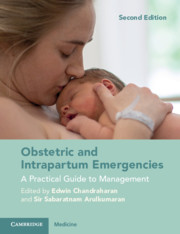Book contents
- Obstetric and Intrapartum Emergencies
- Obstetric and Intrapartum Emergencies
- Copyright page
- Contents
- Contributors
- Preface
- Preface to the First Edition
- Acknowledgements
- Section 1 General Principles
- Section 2 Algorithms for Management of the Top Five ‘Direct Killers’
- Section 3 Intrapartum Emergencies
- Section 4 Postpartum Emergencies
- Section 5 Medical and Surgical Emergencies During Pregnancy
- Section 6 Anaesthetic Emergencies During Pregnancy
- Section 7 Neonatal Emergencies and the Management of Immediate Neonatal Problems
- Section 8 Management of Anticipated and Non-anticipated Emergencies in Pregnancy
- Chapter 37 Placenta Accreta Spectrum Disorders (Abnormal Invasion of the Placenta)
- Chapter 38 Peri- and Postmortem Caesarean Section
- Chapter 39 Management of Established Preterm Labour and Rescue Cerclage
- Chapter 40 Failed Operative Vaginal Delivery
- Section 9 Setting-Up Skills and Drills Training in Maternity Services and Reducing Avoidable Harm
- Index
- References
Chapter 39 - Management of Established Preterm Labour and Rescue Cerclage
from Section 8 - Management of Anticipated and Non-anticipated Emergencies in Pregnancy
Published online by Cambridge University Press: 06 May 2021
- Obstetric and Intrapartum Emergencies
- Obstetric and Intrapartum Emergencies
- Copyright page
- Contents
- Contributors
- Preface
- Preface to the First Edition
- Acknowledgements
- Section 1 General Principles
- Section 2 Algorithms for Management of the Top Five ‘Direct Killers’
- Section 3 Intrapartum Emergencies
- Section 4 Postpartum Emergencies
- Section 5 Medical and Surgical Emergencies During Pregnancy
- Section 6 Anaesthetic Emergencies During Pregnancy
- Section 7 Neonatal Emergencies and the Management of Immediate Neonatal Problems
- Section 8 Management of Anticipated and Non-anticipated Emergencies in Pregnancy
- Chapter 37 Placenta Accreta Spectrum Disorders (Abnormal Invasion of the Placenta)
- Chapter 38 Peri- and Postmortem Caesarean Section
- Chapter 39 Management of Established Preterm Labour and Rescue Cerclage
- Chapter 40 Failed Operative Vaginal Delivery
- Section 9 Setting-Up Skills and Drills Training in Maternity Services and Reducing Avoidable Harm
- Index
- References
Summary
Preterm birth is defined by the WHO as birth before 37 completed weeks of gestation. The incidence varies across countries but is currently approximately 8% of all births in the United Kingdom and 11% worldwide. Being born too soon can confer significant clinical deficits throughout life, leading to neuro-developmental disorders such as cerebral palsy, learning impairment and visual disorders; problems which are more likely to occur with greater severity at earlier gestations of birth [1]. Preterm birth may also affect long-term physical health, with a higher risk of cardiovascular disease, and lays a huge emotional and economic burden on affected families [2]. Figure 39.1 is adapted from the EPICURE longitudinal study of morbidity and mortality of preterm infants and demonstrates that with each week of increasing gestation, rates of disability and death decrease substantially. This underlines the importance of timely treatment aimed at preventing and ameliorating the effects of preterm birth.
- Type
- Chapter
- Information
- Obstetric and Intrapartum EmergenciesA Practical Guide to Management, pp. 283 - 291Publisher: Cambridge University PressPrint publication year: 2021



